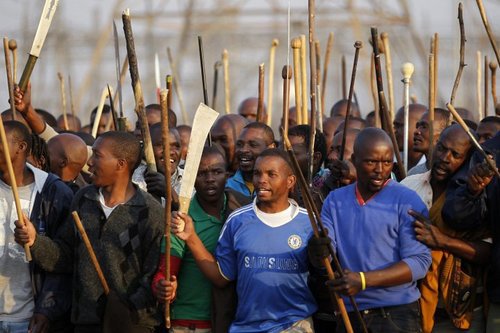Re: A Hungarian Reader Replies To Our Previous British ReaderFrom: Mitchell Day [Email him]
James Fulford wrote that he wanted to
demur slightly from the suggestion that Imperial Britain was evil during the period known as the British Raj.Broadly, and oversimplifying somewhat, the British were the Good Guys, and Indians (including Gandhi) were the Bad Guys.
There are, I'm sure, LOTS of examples of this.....
the Afrikaners were the Good Guys and the Africans (including Mandela) were the Bad Guys.
Or
the Rhodesians were the Good Guys and the Africans (including Mugabe) were the Bad Guys.
Or
The Algerian War. Where the Pieds Noirs (including the OAS and the 1st Foreign Parachute Regiment) were the Good Guys and the FLN (including Saadi Yacef) were the Bad Guys.
VIVE L'ALGERIE FRANCAIS!
See previous letters from Mitchell Day.
James Fulford writes: In the letter last night, I linked to Paul Johnson's defense of the British officer who did what's called the "Amritsar Massacre" in April 1919. [Modern Times, 1991, Chapter 1, p. 45]
One result was an episode at Amritsar on 9-10 April 1919. There were, in Amritsar in the Punjab, one hundred unarmed constables and seventy-five armed reserves. That should have been enough to keep order. But the police were handled in pusillanimous fashion; some were not used at all - a sign of the times. As a result the mob got out of hand. Two banks were attacked, their managers and an assistant beaten to death, a British electrician and a railway guard murdered, and a woman missionary teacher left for dead.
General Dyer, commanding the nearest army brigade, was ordered in, and three days later he opened fire on a mob in a confined space called the Jalianwala Bagh. He had earlier that day toured the whole town with beat of drum to warn that any mob would be fired upon. The same month thirty-six other orders to fire were given in the province.
In Dyer's case the firing lasted ten minutes because the order to cease fire could not be heard in the noise. That was not so unusual either, then or now. On 20 September 1981, again in Amritsar, government of India police opened fire for twenty minutes on a gang of sword-wielding Sikhs.
A similar thing can be seen with the equally iconic Sharpeville Massacre, (1960) in which outnumbered police fired on black South African rioters. It's also internationally famous.In 2012, police from the black-run government of South Africa shot 34 striking miners. See
- Black Police Kill Black Miners “In A Spectacle That Reminded Many South Africans Of The Apartheid Past” And Everyone Else Of ALL THE OTHER GOVERNMENTS IN AFRICA
- More On The Non-Sharpeville Massacre In South Africa
It was covered by Time.com, but has so far caused no international movement to overthrow the black government, the way Sharpeville inspired many people to call (successfully) for the overthrow of the white one. Apparently Black Lives only Matter when white people are involved.













